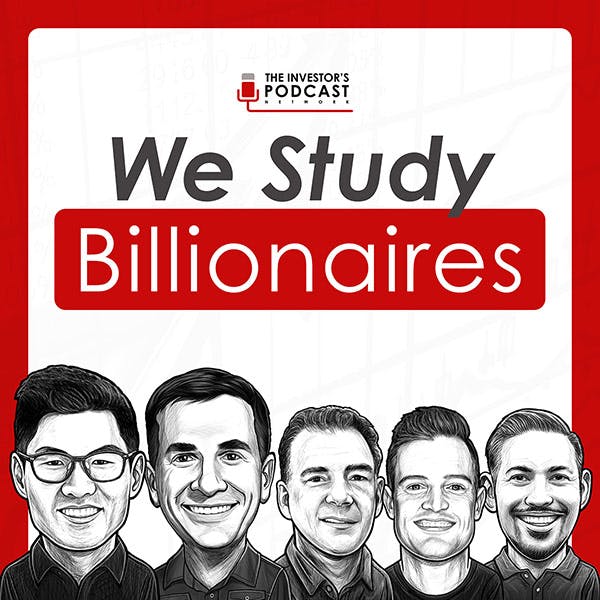
May 19, 2024 • 1hr 20min
TIP632: Mastermind Q2, 2024 w/ Tobias Carlisle and Hari Ramachandra
We Study Billionaires - The Investor’s Podcast Network

Key Takeaways
- Burberry (BRBY) is trading at an attractive valuation of 10x earnings for a luxury brand with over 150 years of history
- Playtika (PLTK) is a mobile gaming company trading at 9.5x free cash flow with 70% gross margins, though growth has slowed recently
- ICICI Bank is positioned to benefit from India's economic growth and increasing banking penetration, though valuation appears stretched
- The luxury sector is currently facing headwinds, particularly for aspirational luxury brands like Burberry
- Mobile gaming companies like Playtika face challenges with user retention and reliance on hit games
- India's banking sector is consolidating, with the top 5 banks now holding 50% of deposits
- Macroeconomic conditions remain uncertain, with mixed signals on inflation, interest rates, and economic growth
Introduction
In this episode, host Stig Brodersen is joined by Tobias Carlisle and Hari Ramachandra to discuss their stock picks and analyze current market conditions. Stig presents Burberry as an undervalued luxury brand, Tobias pitches Playtika as a cheap mobile gaming stock, and Hari makes the case for ICICI Bank as a way to invest in India's growth story. The discussion covers the bull and bear cases for each company, as well as broader economic trends impacting the market.
Topics Discussed
Current Economic Conditions (1:57)
The discussion begins with an analysis of the current economic environment, which appears to be defying conventional wisdom:
- Interest rates have risen at the fastest pace in history, but inflation is not coming down as quickly as expected
- Housing prices and the stock market continue to rise despite higher rates
- Geopolitical tensions and wars do not seem to be significantly impacting key wealth indicators
Tobias Carlisle offers his perspective:
- The yield curve inversion (short-term rates higher than long-term) has persisted longer than usual
- Massive fiscal deficits and government spending may be offsetting the impact of higher rates
- "We're in a grand experiment. I don't think any of this has been tried before. We've got the brakes on and the accelerator on at the same time."
Stig Brodersen emphasizes the importance of maintaining a long-term perspective and not trying to time the market based on macroeconomic predictions. He suggests holding physical gold as a hedge against potential currency debasement.
Disruption in the Technology Sector (13:37)
The conversation shifts to discussing the current state of innovation and disruption in the technology sector:
- There is a perception that the pace of disruptive innovation has slowed
- Large tech companies may be stifling competition and making it harder for new disruptors to emerge
- AI technology may be reinforcing the power of centralized, well-resourced companies
Hari Ramachandra notes:
- Many tech companies are now focusing on "responsible growth" and margin improvement rather than pure revenue growth
- There have been fewer truly consequential new tech companies emerging in recent years compared to the 2010s
- "We aren't innovating fundamentally the way we did in the 1900s. We are just going after photo apps or social network apps and thinking it is innovation, but it is just application of a fundamental innovation which was Internet."
Burberry (BRBY) - Bull Case (17:30)
Stig Brodersen presents his investment thesis for Burberry:
- Trading at only 10x earnings, an unusually low multiple for a luxury brand
- Over 150 years of brand history provides some durability
- Stable 70% gross margins and 20% operating margins
- Currently refurbishing stores, which has shown 15% sales increases per square meter
- Targeting 50% of revenue from accessories (currently 37%)
- 5% dividend yield while waiting for potential multiple expansion
Stig argues that Burberry should be considered a luxury brand rather than pure fashion:
Burberry (BRBY) - Bear Case (35:18)
The discussion then covers potential risks and downsides for Burberry:
- Low insider ownership and potentially misaligned management incentives
- Luxury sector currently facing headwinds, particularly for aspirational luxury brands
- Burberry is more exposed to economic cycles than ultra-high-end luxury brands
- Brand perception issues in some markets due to past associations
- Reliance on hit collections and changing fashion trends
Tobias Carlisle raises a concern about past brand perception:
Playtika (PLTK) - Bull Case (42:35)
Tobias Carlisle presents his investment thesis for Playtika:
- Trading at 9.5x free cash flow and 11x earnings
- 70% gross margins and 20% operating margins
- $2.7 billion market cap with $2.6 billion in expected revenue
- Recently initiated a 5.5% dividend yield
- Founder-CEO still running the company
- Potential for acquisitions or being acquired in consolidating industry
Tobias sees Playtika as an undervalued company despite recent challenges:
Playtika (PLTK) - Bear Case (52:23)
The discussion covers potential risks for Playtika:
- Revenue growth has slowed to just 1% year-over-year
- Daily active users declining by 6-7% year-over-year
- Challenges with user retention and reliance on hit games
- Privacy changes have made user acquisition and monetization more difficult
- Potential regulatory risks for casino-style games
- Geopolitical risks with operations in Israel and Ukraine
Hari Ramachandra notes concerns about the business model:
ICICI Bank Limited - Bull Case (56:01)
Hari Ramachandra presents his investment thesis for ICICI Bank:
- Fifth largest bank in India with $128 billion in deposits
- Positioned to benefit from India's strong economic growth (7-8% GDP growth)
- Increasing banking penetration and digitalization in India
- 10% deposit growth and 14% loan growth (5-year CAGR)
- 17% net income growth (5-year CAGR)
- 4.3% net interest margin
- Recognized as a systemically important bank by regulators
Hari sees ICICI Bank as a long-term play on India's growth story:
ICICI Bank Limited - Bear Case (1:12:47)
The discussion covers potential risks and valuation concerns for ICICI Bank:
- Trading at 3.7x price-to-book value and 18.5x P/E ratio
- Valuation appears stretched compared to developed market banks
- Past scandals and periods of underperformance
- Competition from state-owned banks and other private banks
- Potential for economic slowdowns or banking sector issues in India
- Currency risk for international investors (though rupee has stabilized recently)
Tobias Carlisle raises a concern about valuation:
Conclusion
The episode provides in-depth analysis of three diverse investment opportunities: Burberry as an undervalued luxury brand, Playtika as a cheap mobile gaming stock, and ICICI Bank as a play on India's growth. Each pick offers potential upside but also comes with significant risks and challenges.
The broader discussion highlights the current uncertain economic environment, with mixed signals on inflation, interest rates, and growth. The conversation also touches on important trends in technology disruption, luxury goods, mobile gaming, and emerging market banking.
Ultimately, the episode emphasizes the importance of thorough research, understanding both bull and bear cases, and maintaining a long-term perspective when making investment decisions. While macroeconomic factors are important to consider, the focus remains on identifying individual companies trading at attractive valuations relative to their growth prospects and competitive positions.









